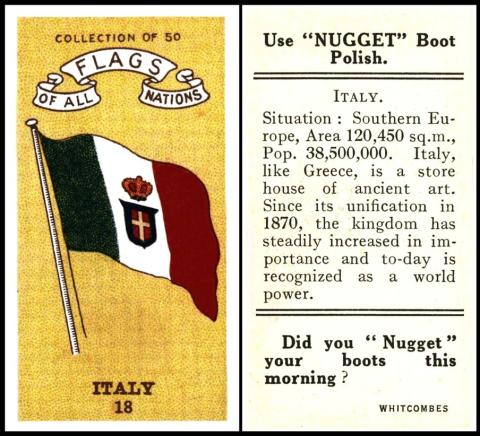
This is Italy, almost the last of our founding countries of Europe, though if you look back in time it was the Roman Empire who had the idea of colonising many countries under one banner, which, in a much more peaceable way, is the same idea of Europe.
After the Second World War parts of Italy were given to other places, including all of its former colonies. Then, in 1949, it followed a similar route to several of our other countries from this week and joined the North Atlantic Treaty Organisation, or NATO the idea of which is to look after your own country, but also protect those with whom you share a border. This brought them into the effect of the United Nations, and then into the European Economic Community in 1957.
So lets start our card chat with a very brief chat about polish, which is purely to soften and waterproof leather, not to shine it. Yes, that surprised me too.
In early times it was often made by the shoe wearer themselves (or their servants) out of wax, tallow and oils. It was not until the 18th Century that it took on the idea of shining the item, and also when the ingredients were changed to beeswax, or lanolin from sheep.
Strangely, after that the shininess became outmoded and the requirements were for blackness. I am actually wondering if this had something to do with the Army, or with wars? Anyway the same beeswax and lanolin were still used but the makers added something very unusual to make it black - namely soot. The idea of darkness remained but some manufacturers went away from soot, indeed the earliest reference we have to a shop sold shoe polish in the early 19th century was made of vinegar, sugar and black dye, diluted with water, possibly also the water was to dilute the rather whiffy niffs of the vinegar so the wearer did not have to fight off the stray cats who followed them down the street. This idea was soon abandoned though, because the black dye was not of the permanent kind, and transfer and staining was impossible to prevent. Another popular ingredient was sulphuric acid, which is why if you look at a Nugget tin it will say "Free from Acid"
Nugget was one of the first branded polishes. It was amazingly successful and was sold across the globe. The company was Nugget Polish Company, and they were based at the Kennington Oval, near the Cricket ground which was founded in 1845.
They teamed up with a rival, the Chiswick Polish Company, in 1916, and it seemed to be a sharing of profits scheme, which, for all sorts of reasons, soon failed. It was all over, probably bar the shouting, by 1919. We know that Nugget as a brand continued after this, and that at the 1922 British Industries Fair they were exhibiting polishes and creams along with white buckskin cleaning cream and polishes for furniture and horse harnesses.
Then it all get a bit confusing and Chiswick Products are back on the scene in another merger of sorts. Reportedly Nugget was then lost as a brand, and the polish was retailed under the Chiswick name, but this cannot be true for we have adverts of Nugget being sold in New Zealand well into the mid 1930s. And they appear as one of the brands on a rather nice set of playing cards in the 1950s.
And then we read that Nugget closed down in 1967.
Our original British Trade Index of 1962, older, even, than me, lists Nugget simply as “polish”, which means it was not entirely that for shoes. It says that the cards were issued “about 1910-1925”, and lists four sets in alphabetical order. Our set is catalogued as :
FLAGS OF ALL NATIONS. Sm. 69 x 36. Nd. (50) … NUG-3
However, in our updated British Trade Index of the year 2000, the header says “Boot Polish”. It also has a big surprise, because the cards are catalogued as :
FLAGS OF ALL NATIONS. 1925. 69 x 36. Nd. (50) Vari-backed, 26 different backs known. See HN-47 … NUG-070
HN-47 is the Handbook reference, and, curiously, this does not list the cards, but the backs. Here is the listing, scanned in.
If you look at that list you will find the cards were issued with floor polish too, look at backs 5, 11, 16, and 24.
Returning to our updated British Trade Index, rather than the Handbook, we find that there are also has additional stable-mates, which are an advertisement card of a tin, (but there are almost certainly others, lurking, in the hands of ephemera and postcard collectors) - and eight different sheets of “Dogs” (A), though more correctly it ought to have been dog’s heads, or even, perhaps, “Magic Numbers”, which appears on the bottom of the sheets. This was designed as a game, a kind of bingo. Would like to see one of these, if you have one...

